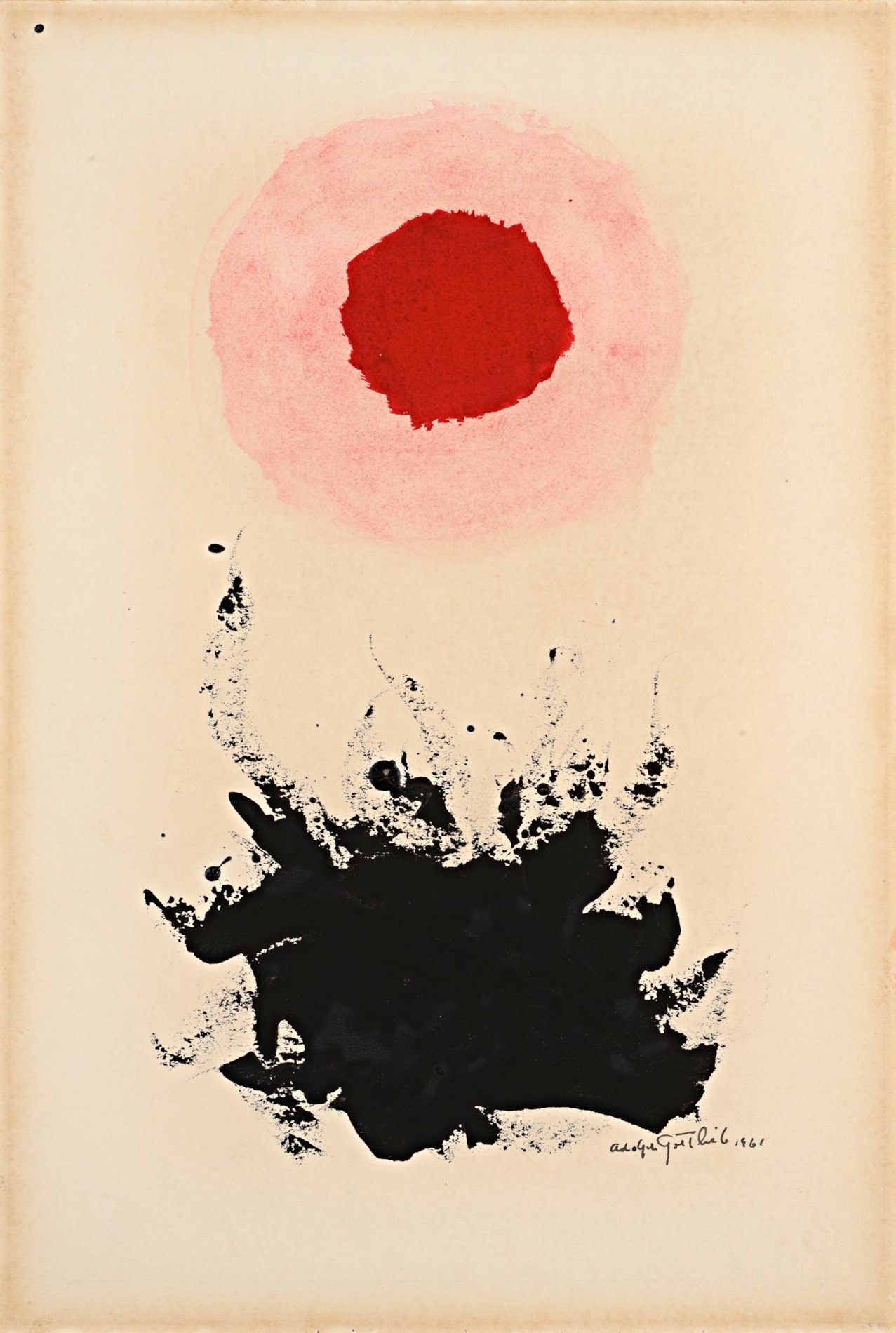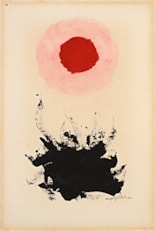Adolph GOTTLIEB
(New York 1903 - New York 1974)
Untitled
Sold
Red and black ink on paperboard.
Signed and dated Adolph Gottlieb 1961 at the lower right.
378 x 254 mm. (14 7/8 x 10 in.)
Signed and dated Adolph Gottlieb 1961 at the lower right.
378 x 254 mm. (14 7/8 x 10 in.)
This is a superb example of Adolph Gottlieb’s draughtsmanship at the height of his career. Though the artist’s drawings remain somewhat less studied than his paintings, it has been noted that such works were intended as autonomous works of art, rather than as preparatory studies for paintings. Indeed, in many cases, Gottlieb’s works on paper can be seen to develop and refine the compositional ideas that he was simultaneously exploring in his much larger paintings. As the Gottlieb scholar Mary Davis MacNaughton has written of the artist, ‘His works on paper are not as well known as his paintings, having been exhibited less often, but they embody his artistic vision just as powerfully. As small works, they functioned like sketches, allowing him to express his visual ideas in the freshest way. But these works were not traditional sketches; in other words, they were not studies for paintings, but rather independent works that paralleled his paintings. Their energy is equally dynamic, but their scale is more intimate.’
The composition of this vibrant drawing, drawn in 1961, is derived from the series of early Burst and Blast paintings of 1957 and 1958, in which Gottlieb developed a new and simplified imagery that would soon develop into the signature style of the final part of his career. As these seminal works have been described, ‘two forms, roughly equal in area, one above the other; they do not touch, but it feels as if they were bound together, as by planetary forces. The lower form is black and painted in a choppy gestural way; the upper form, red, is smoother in surface and edge, but not closed or measured. It is the product of another type of gesture: the ellipse is freely brushed and surrounded by a tonally graduated halo.’ The juxtaposition of the two zones of the Burst compositions, contrasting the stillness of the oval shape and the dynamism of the expressive marks below it, is a feature of the present sheet.
Although the titles of some of the Burst paintings seem to suggest bombs or explosions, and indeed several critics saw in these works – painted at the height of the Cold War - a reference to the atomic bomb, the artist was less forthcoming about what they were meant to represent. As Gottlieb was quoted in a newspaper interview at the time of the 1963 São Paulo Bienal, where his work won the Grand Prize, ‘I try, through colors, forms and lines, to express intimate emotions...My paintings can represent an atomic bomb, a sun, or something else altogether: depending on the thinking of whoever is looking at it.’
A closely comparable drawing in ink and gouache, dated December 1960, was recently sold at auction in New York.
The composition of this vibrant drawing, drawn in 1961, is derived from the series of early Burst and Blast paintings of 1957 and 1958, in which Gottlieb developed a new and simplified imagery that would soon develop into the signature style of the final part of his career. As these seminal works have been described, ‘two forms, roughly equal in area, one above the other; they do not touch, but it feels as if they were bound together, as by planetary forces. The lower form is black and painted in a choppy gestural way; the upper form, red, is smoother in surface and edge, but not closed or measured. It is the product of another type of gesture: the ellipse is freely brushed and surrounded by a tonally graduated halo.’ The juxtaposition of the two zones of the Burst compositions, contrasting the stillness of the oval shape and the dynamism of the expressive marks below it, is a feature of the present sheet.
Although the titles of some of the Burst paintings seem to suggest bombs or explosions, and indeed several critics saw in these works – painted at the height of the Cold War - a reference to the atomic bomb, the artist was less forthcoming about what they were meant to represent. As Gottlieb was quoted in a newspaper interview at the time of the 1963 São Paulo Bienal, where his work won the Grand Prize, ‘I try, through colors, forms and lines, to express intimate emotions...My paintings can represent an atomic bomb, a sun, or something else altogether: depending on the thinking of whoever is looking at it.’
A closely comparable drawing in ink and gouache, dated December 1960, was recently sold at auction in New York.
One of the founders and leaders of the seminal American movement known as Abstract Expressionism, Adolph Gottlieb was born in New York and studied with John Sloan at the Art Students League, and later at the Parsons School of Design and Cooper Union. He became a close friend of fellow artists Mark Rothko and Milton Avery, with whom he worked closely throughout the 1930’s, as well as Barnett Newman and David Smith. In 1941 he began to paint his first major series of works, known as Pictographs, several of which were exhibited the following year at the Wildenstein Gallery in New York. In 1943 Gottlieb became a founder member of a group known as the New York Artist-Painters, which included Rothko and John Graham. Gottlieb’s mature oeuvre can be divided into three major series of works produced, sometimes concurrently, in the 1940’s, 1950’s and 1960’s: the Pictographs of 1941-1953, the Imaginary Landscapes, dating from 1951 onwards, and, finally, the large Burst paintings begun in the late 1950’s, which are the artist’s best known works.
The first painting of this type, entitled Burst, was exhibited at the Martha Jackson Gallery in New York in 1957, and was quickly followed in the same year by the closely related paintings Blast I (today in the Museum of Modern Art, New York) and Blast II. These vertical paintings of contrasting but balanced forms - an oval shape, sometimes with a halo or nimbus of thinned paint around it, in the upper half, and jagged black marks in the lower zone - were to provide a template for much of Gottlieb’s output between 1957 and his death in 1974. In the words of one scholar, ‘Oscillating as it does between figural and landscape implications, Gottlieb’s Burst image is a blood brother to Rothko’s stacked-rectangle and Newman’s vertical-band signature images. All have iconic force because of their upright posture, their holistic compression, and their drastic simplification. All are condensed, resonant, luminous, and powerful...In [Gottlieb’s] mature images he achieved what he saw as the quintessence of abstract art – the reduction to a simple resonating object that embodies maximum complexity.’
In succeeding years the artist expanded the dimensions of these paintings and began using colours other than red and black. In 1966 the contents of Gottlieb’s studio were destroyed in a fire, with the result that much of his output of the 1960’s is lost. A retrospective exhibition of the artist’s work, held at both the Guggenheim and Whitney Museums in New York in 1968, marked the apogee of his career. In 1970, however, Gottlieb suffered a stroke that paralyzed the left side of his body. Though confined to a wheelchair, he continued to paint until his death four years later.
Provenance
Acquired from the artist by a private collector
Anonymous sale, New York, Sotheby Parke Bernet, 28 May 1976, lot 367
André Emmerich Gallery, New York
Acquired from them in 1977 by a private collector
Private collection.
Anonymous sale, New York, Sotheby Parke Bernet, 28 May 1976, lot 367
André Emmerich Gallery, New York
Acquired from them in 1977 by a private collector
Private collection.
Exhibition
New York, André Emmerich Gallery, Adolph Gottlieb: Paintings 1945-1974, 1977 [ex-catalogue].




